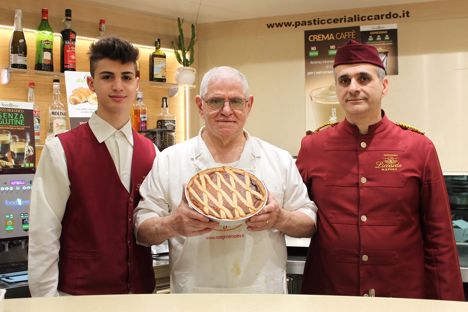
The pastiera: Italy's most festive cake
Luciana Squadrilli charts the history of the pastiera, a seasonal cake that's eaten during Easter and Christmas.
Talking about pastiera – the delicious tart from Naples – with Italians would likely raise more than one argument: is it a Christmas or Easter cake? Do you put wheat, rice or pasta in the filling? Should custard (crème pâtissière) be added to the filling, or not? How thick should it be?
Answering such questions is not easy; as with many other traditional recipes handed down from mother to daughter – see ragù – almost every single family has its own version, cherished as a part of their heritage and, of course, considered to be the best ever. Also, many regional variations exist and even the name of a dish is sometimes disputed.
I talked to Tommaso Esposito, a sophisticated gourmet and passionate food historian at the helm of the Pulcinella Museum in Acerra, to help me retrace the origins and boundaries of the original pastiera. ‘Mentions of a so-called pastiedda, as it is sometimes still called today in some areas of Campania, date back to the sixteenth century, when the term generally referred to a kind of savoury or sweet pie made with wheat, rice or tagliolini pasta (depending on the area), and other ingredients such as provatura (a forebear to mozzarella), cheese or salami,’ he explains. ‘Neapolitan poet Giovanni Battista del Tufo mentioned it in his essay on Naples' wonders, but it was only in the 1800s that something more similar to what we eat today was described by Ippolito Cavalcanti – a kind of shortcake using lard instead of butter and filled with boiled wheat, ricotta cheese, eggs, candied fruit, cinnamon and other spices, that he recommended should be eaten warm.’ By then, the pastiera became a typical food around Easter – wheat, ricotta cheese and eggs symbolized fertility and renaissance, thus representing the return of spring and the resurrection – and it was commonly prepared by nuns.
Given the utterly delicious taste of this rich tart, its fragrant aroma and the irresistible citrusy taste (as orange flower water or oil is now considered a trademark of a proper pastiera) many bakeries now prepare it all year round. It is considered a ‘festive’ pie and is also commonly eaten at Christmas, along with other traditional cakes such as struffoli (small fried balls of dough with honey) and roccocò (spiced round biscuits).
Pastiera today
So, what are the features of an amazing modern pastiera? According to Tommaso Esposito it should be three to four centimetres thick, with a faultless, crumbly crust made with good quality eggs and butter. As for the filling, ricotta and wheat (which is boiled in water or precooked and then added to milk, butter and lemon zest to make a sort of cream) must be perfectly balanced and the cereal should keep its crispness. Candied fruit should include lemon, orange and citron, but those who stick to the traditional recipe also add cocozzata (candied pumpkin).
There is no point in adding custard since the wheat filling is already dense and creamy, yet many people do, especially in the Salerno area, south of Naples. This is to follow a tradition which was apparently launched in the twentieth century by a Neapolitan pastry chef called Starace to make it even richer. The crust should not be too thick; since the filling is moist, the pastiera is cooked, sold and served in appropriate tins called ruoti (rounds, from their shape) and if the result is good enough, nobody will be too fussy about the container.
A good pastiera should not be sickly sweet and orange flower water should be used very carefully. To taste the cake at its best, it has to be cooked some days in advance (at home, it is usually made on Good Friday) to allow the different flavours to blend together.
There are other varieties of pastiera which can be found in Campania (and, if you are lucky enough, in other Italian cities where Neapolitan pastry chefs work) which change according to local tradition or personal innovations. In the Caserta area, many people still use pasta (a kind of very thin spaghetti such as tagliolini or capelli d'angelo) instead of wheat – an option that can be tasted at the Mennella bakeries in Naples and Torre del Greco. The pasta is boiled and left to rest for twenty-four hours in a sugar and eggs batter, then added to pastiera without ricotta.
In Sant'Egidio Montalbino, a small village near Salerno, the acclaimed pastry chef Alfonso Pepe – who succeeded in making a panettone considered among the best of Italy, recently created something new. His ‘risen’ pastiera is a fantastic mix of the traditional recipe and a leavened cake such as colomba or panettone. He makes a classic dough for the colomba using a natural starter, which rises overnight; on the day after, he adds the traditional pastiera filling, although without the orange flower flavour; he uses a ‘cream’ of blended candied orange instead. The result is a soft, light cake which has all the seductive aromas of pastiera but doesn’t fill you up like the classic pie does. The final touch is the syrup made with orange blossom liqueur, which he spreads over the cake's crust to give it the unique scent of spring.
Francesco Guida, son of chef Peppe, is an excellent pastry chef and baker. His leavened cakes are outstanding, but the pastiera alone is worth the trip to his family restaurant in Vico Equense, as well as his father's dishes.
In the Vomero area of Naples, Liccardo is a family-run pastry shop where it is possible to buy a delicious, classic-style pastiera.
Originally based in Torre del Greco in the outskirts of Naples, today Mennella runs three shops in Naples and six in the Vesuvio area. From an ancient family tradition, here it is possible to find pastiera made with capelli d'angelo (angel's hair) pasta.
Award-winning pastry chef Alfonso Pepe makes an excellent traditional pastiera, as well as his original ‘pastiera lievitata’. Both are definitely worth the trip to Sant'Egidio Montalbino, but it is also possible to find the leavened version in some shops in Naples and Rome.
Experienced pastry chef Sabatino Sirica is the creator of one of the best pastiera to be found in all of Campania, and the most authentic for sure; he still uses strutto (lard cream) to make the crust, giving it extra flavour and crumbliness.
Luciana Squadrilli

